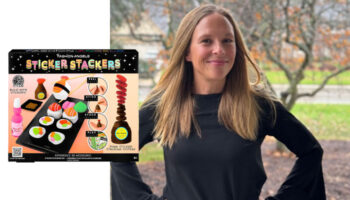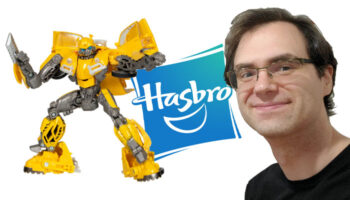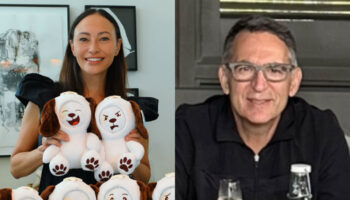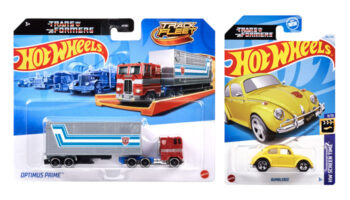IDEO’s Michelle Lee talks Twister Air, creativity and the power of play

Michelle, it’s great to catch up! Let’s start at the beginning… What set you on a path into toys? Was it always part of the plan?
Not so much. It was quite a twisty road to get here. Sometimes I joke that I ended up in toys because I wanted to make all the toys I wasn’t allowed to have as a child. But, in fact, I think a lot of us start off as toy designers as children. I can remember making houses out of cardboard boxes, creating my own puppets and making up games with my brother. It comes naturally when we’re young.
Absolutely. So did toys as a career pop up as an early ambition?
Not at all. Early on, I felt the pull to do something that felt responsible and grown up, so I originally majored in Mechanical Engineering. While I was doing that, I realised there were students that were taking Math and Science classes with me, and then they’d go off and take Art and Design classes. They seemed to be having a lot more fun than I was! That led me to Product Design.
I remember meeting David Kelley, the founder of IDEO and the d.school at Stanford, during my senior year. Back then, the d.school didn’t exist, so he was heading up the Product Design department. He was teaching a class called Human Values in Design and told me I could take it and drop out after two weeks, but that it would give me a good taste of what design was… That suckered me into LOVING design. More than 20 years later I’m still here and working for IDEO.
So that’s what brought you to toys?
Not quite there yet! My summer internships were in aerospace. I spent hours in front of machines watching really large CAD files load… I soon realised that’s not what I wanted to be doing with the rest of my life.
My breakthrough came when I was in one of my friend’s rooms, and he had toys everywhere. I thought: ‘Hey, someone had to design those… Why couldn’t that be me!?’ At that point, I told everyone that I wanted to design toys because that was the only way to find jobs in the toy industry. Everyone who came to our school’s Engineering job fairs were from the aerospace or automotive industries… I had to go by word of mouth.
And, it worked, because I got a summer internship with an independent toy inventor, which led me to VTech Toys, which led me to University Games… Then I returned to grad school for Design and landed at IDEO.
However, when I came to IDEO, I shunned toys again – that whole bit about needing to act like a grown up! – and started out with consulting projects in education, consumer products, food and beverage… Anything but toys. However, the pull of play was strong, and I’m now full-circle, leading IDEO’s Play Lab. I told you it was a winding path!
You weren’t wrong! And who was that toy inventor that you did the internship with?
That was Tony Hu. At the time, he had a small invention studio called Primal Products. Now he runs a graduate program at MIT, so he’s had his own winding path. But he still has the heart of a toy inventor, and we’re still in touch. He even sent us an all-star intern a couple years back.
Amazing. Before we dive into IDEO’s Play Lab, for anyone new to IDEO more broadly, how would you describe what it does?
IDEO is a design firm that takes a human-centred approach to designing products, services and experiences — likely many that you’ve interacted with regularly without even knowing it. Our first product was the Apple Mouse; it was the first computer mouse that an everyday user could purchase.

Since those days, we’ve learned that we can also apply our design process to helping companies design strategies and even build new capabilities within their companies.
IDEO has an incredible reputation. What makes it a special place to work?
For one, the human-centred approach is something I really value. Rather than the idea of a solo designer having a flash of brilliance, it’s more about being curious and inviting others into the design process with us so that we experience things from different points of view and broaden our thinking. That becomes inspiration for developing new solutions that we hope are better for the world and that better serve people’s needs. I love that I am constantly exposed to new people, new ideas and new challenges.
And, while the Play Lab is known for being intentional about play, IDEO as a whole is a very playful place. If you were to walk into our office, you’d see that immediately. It’s a place where people are having fun doing what they’re doing, because we’re constantly inventing and coming up with new ideas. It’s rare to find somewhere that feeds your curiosity like IDEO. It lets you do what you did as a child – to dream and make things that take you towards a new reality. It’s really powerful.
Also, I work with some of the most incredible designers! The most skilled, passionate, and fun team you could imagine.
And how would you describe the Play Lab’s function within IDEO?
The Play Lab has two different businesses. On one side, we invent and license toys and games. We’ve done that for over 30 years and work with all the big toy companies to do so. We’ve collaborated on everything from an infant toddler line with Melissa & Doug, to mobile-enabled games like Pictionary Air, to several generations of the Barbie campers.

The other side of the Play Lab business is consulting. Our team brings a play lens to how we tackle the challenges that come to IDEO. That might span education, workplace culture, climate, healthcare and more. We help partners adopt a playful mindset when they tackle these challenges, so they can be more divergent and imaginative in their problem-solving. We bring in tools, processes and learnings from play, such as using role-play to help clients imagine and feel the future. This is helpful when it can be hard to see past the way things are done today.
Play lets us dream about what the future could be. Only after we see it, can we make it real.
Do the two sides influence each other at all?
We try to keep toy invention and play consulting close together. While people will typically get hired to work predominately on the invention side or the consulting side, we cross over. We’ll put inventors on consulting projects and vice versa. We also often pull in designers from the larger consulting pool across the rest of IDEO to support both businesses.
The consulting side will expose our team to the latest tech trends and social trends, and other disciplines like medical device design that can provide interesting inspiration when thinking about things like mechanisms. As you can imagine, that can be really helpful on the invention side. In return, the invention team knows so much about working with kids and families and are also incredibly experienced at making things tangible fast, as well as optimising for manufacture. That’s very useful to different parts of IDEO’s business.
Sounds like a terrific USP. Is there a toy invention from IDEO that you feel came about as a result of having these sides of the Play Lab working closely together?
A recent example would be Twister Air. It was hard to miss the trend of people being thrilled to capture videos and share these videos of themselves doing interesting dances on social media. We saw that trend across both toy invention and in research we were doing for consulting projects focused on Gen Z. It was obvious there was something interesting there, so we mashed up that idea with the classic game of Twister.
The game is about getting people to contort their bodies by matching colourful bands on their wrists and ankles with dots that appear on a screen. If you match things correctly, you find yourself doing actual dance moves.

Fantastic. Did it take a lot of work to get that first mock-up doing what it needed to?
Well, we started out super lo-fi, just to test out the experience to make sure it looked fun before investing in building out the full tech. We filmed people doing the moves first, and then, during video production, we placed dots over them to match the moves. Once we saw something intriguing and Hasbro showed interest as well, we had to figure out how to actually make it!
Our toy inventors worked with our interaction and software designers from the consulting side, as well as engineers from other parts of IDEO. Together they nailed a fully working prototype that combined the digital and physical aspects.

How soon did it become clear that Twister was a nice fit for that trend? Did you explore other ideas around the trend for people recording and sharing their dances?
We love to do mash-ups. It’s a form of brainstorming that we cooked up in the Play Lab, where we break a question down into parts, and brainstorm quick lists for each part. Then we see what we can bring together from each list to create a completely new idea. So, for example, in this case, we would brainstorm around ‘Games we all know and love’ and ‘Interesting trends.’ Taking ‘Twister’ from one list and ‘Dance Videos on TikTok’ from the second list, we arrive at the idea of linking Twister with dance moves. As we build out the idea, someone else adds in the idea of coloured wristbands. And, we keep going until we have a complete toy idea that we can mock up and pitch.
Design and play have a great knack for looking at lots of ideas that seem unconnected and bringing them together so that established things come to life in brand new ways.
Absolutely. I also wanted to talk to you about a new course that IDEO has launched: ‘Creative Thinking for Complex Problem Solving.’ The next cohort starts in August. What can you tell me about that?
I co-teach this class with a brilliant designer, Kate Schnippering. We’re seeing that people are dealing with a lot of hard challenges around the world. It’s a world that’s highly interconnected and where information is shared very quickly, making many of the challenges more systems based and involving many different stakeholders. Our actions can result in big impact and widespread consequences. And because these challenges are so big, they’re also daunting.
This course combines play with rigor as an approach to solving these challenges. The reason I co-teach this class is because I strongly believe in the value of bringing a playful mindset to hard work. It’s about being curious and seeing problems from unique angles. It’s about challenging conventional thinking. Like children, we need to ask: Does it really need to be that way? Can it be something different? Like when a box isn’t just a container but also a store or rocketship! When we start asking questions, we realise that we have a lot of false assumptions which we can change.
Bringing play together with a rigorous design process makes it a very interesting lens for problem-solving. And, with play, it’s a lot more fun, too!
Sounds fascinating. We’ll pop a link to that here: https://www.ideou.com/products/creative-problem-solving. Now, you mentioned the power of play can help people tackle issues in any industry… How do you convince the more ‘buttoned up’ serious sectors to embrace a playful mindset?
The beauty of play is that it’s something most people experienced as children. A large part of it is just reminding people what they did before and how powerful it was. Play is how kids make sense of the world; it’s a superpower. As adults, we’re still confronted with new challenges, and we certainly don’t understand everything. And yet, we’ve abandoned that ability to play and don’t give ourselves permission to do so… It doesn’t make sense.
To get back into play requires baby steps. You can’t just push people into a crazy improv exercise straight away! I don’t believe in forced fun, so you need to read your crowd. If someone isn’t comfortable with it, we’ll start with an easy exercise. It might just be to say: ‘Close your eyes and imagine yourself blasting off into space. Tell me, what did you see?’ I then remind them of how much more they saw when they were children. That can help people understand the power of play.
And we need to bring back that playful spirit to take on these big challenges. For some reason, we feel we have to be serious all the time, but no one has ever equated being serious with being successful or more effective. Play can push ideas further and it’s a great way to sustain momentum. When we’re tackling challenges that we know we’re not going to solve in a few days or weeks, we need momentum.
Are there any big challenges in particular that you feel play has the power to help solve?
Climate is an area I’m very passionate about. Climate is daunting. You catch people’s attention when you tell them the world is burning, but then people feel the pressure to come up with the perfect solution – and then they do nothing because they don’t know what the perfect solution is.
If you approach this same challenge in a playful way, by trying things out with a view that if it goes wrong, you can try again… That leads to progress and with these types of challenges, progress is more important than perfection – because we’ll never get to perfection if that’s what we’re shooting for at the beginning.
Also, how can we think optimistically and look at this as a chance to come up with new and better ways to do things? Look at plastic in the toy industry. What if we don’t limit ourselves to the challenge of finding a one-to-one replacement for plastic as we use it today, but instead explore new materials through a lens of what fresh possibilities they might offer play-wise.
A seaweed-based plastic alternative behaves differently with liquids and has different material properties. It might be more stretchy. What new toys and play patterns might that inspire? If we can come up with fresh, new solutions in toys – an industry that turns over products year after year – other industries will see that it’s possible and will follow.
Before we wrap up, I wanted to ask what fuels your creativity?
I have an 11-year-old and a 13-year-old and they constantly open my eyes to see the world from a fresh perspective. As adults we see things and take them for granted. This object was built for a purpose and that’s that. Kids see things differently and ask a lot of questions… My 11-year-old recently asked me: “What came first, orange the fruit or orange the colour?” It stopped me in my tracks. I had never thought about it before!
And what is the answer?
Orange the fruit came into being 200 years before orange was used as the name for the colour. He’s constantly asking me questions like that, and it encourages fresh ways of thinking. Adults sometimes shy away from questions because they want to have answers. I believe questions are more important than answers.
Fantastic. And what kills creativity for you?
Creativity dies when we’re overprogrammed. As adults, we’ve come to think that being busy is something to brag about. We fill our days and talk about how many meetings we have. We no longer have time to let things swirl around in our brains for a bit and make those important connections that I mentioned earlier. That’s why people’s best ideas sometimes come to them in the shower. It’s when our brains have some downtime.
When I’m working from home and have time between meetings, I’ll run and grab my guitar. Playing a few songs is enough to free my brain. It also gives me joy to keep on with my day. It helps unlock ideas and gives me momentum if something has stalled.
Good answer. My last question: What do you think is IDEO’s most underrated creation?
There are so many! One that comes to mind is the Willow breast pump. It has won many awards so is well recognized, but I would give it more if I could. I so wish it was around when my children were babies! At the time we worked with them, Willow was a small start-up. They looked at this contraption that women attach themselves to for hours each day. It’s loud, it’s clunky… You have to block off time on your calendar to do it. So Willow came to us and said: Can you take the whole pump and put everything into a contraption that fits into a woman’s bra? We helped them with engineering and industrial design while being sure to talk to many moms in the process.

Now, women can just slip the Willow breast pump into their bra and go about their business. Someone wrote to us and said: ‘Thank you for inventing the Willow Breast Pump. I’ve just returned from marching at a women’s march, while I was pumping for my child.’ I was like wow! Talk about how an invention can have deep impacts on society and empower members of our population. That’s one I love.
A brilliant pick. Michelle, a huge thanks again. Let’s catch up again soon!
–
To stay in the loop with the latest news, interviews and features from the world of toy and game design, sign up to our weekly newsletter here























